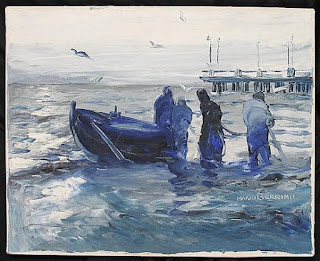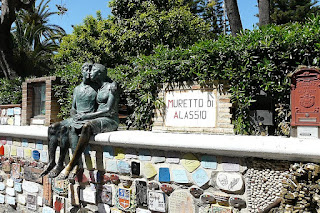Artist who was also a popular entrepreneur
The painter and entrepreneur Mario Berrino was born on this day in 1920 in Alassio, the coastal town in Liguria where he spent almost all his life.
Berrino captured many scenes from life on the
coast of Liguria in and near his home in Alassio
Berrino took up painting full time in his 50s and his simple yet atmospheric and evocative works became sought after by collectors, often selling for hundreds of euros at auction.
Alassio has a gallery dedicated entirely to his work, as does the jet set playground of Monte Carlo, about 100km (62 miles) along the riviera coastline to the west, not far from Italy’s border with France.
Before that, Berrino had lived a colourful life in and around his home town, his entrepreneurial spirit shining through in many projects that left a lasting impression on Alassio.
As a young man, he helped his father and brothers run a bar and restaurant in Alassio, the Caffè Roma, which earned fame in the years between the First and Second World Wars as a hang-out for writers, artists, and musicians, among them the American novelist Ernest Hemingway, who was a frequent visitor to Italy and became a close friend of Berrino.
It was when Hemingway was in Alassio in 1953 that Berrino hatched the idea of attaching brightly coloured tiles to the low wall of a public garden opposite the Caffè Roma bearing the signatures of artists who had visited the restaurant.
 |
| Il Muretto di Alassio, which Berrino created on a wall outside the Caffè Roma, still attracts visitors |
The wall became known as Il Muretto di Alassio and remains a tourist attraction today, with close to 1,000 tiles, the criteria for inclusion expanded to include personalities from cinema, television, fashion, entertainment and sport.
In the same year as the wall came into being, Berrino launched a beauty contest, Miss Muretto, which was held every year until 2013. The winners include several women who have gone on to achieve a degree of fame, including the TV presenters Simona Ventura, Maria Teresa Ruta, Elisa Isoardi and Melissa Satta.
Berrino launched himself with enthusiasm into several other entrepreneurial ideas, cashing in on Alassion’s reputation for invigorating sea air by selling l’Aria Pura di Alassio in 500 litre jars, for which he received orders from all over Europe.
.jpg) |
| Berrino on the occasion of a 90th birthday celebration in Alassio |
He was a popular figure in Alassio, usually seen driving his red Fiat Ghia 500 Jolly, a specially adapted Fiat 500 with a removable canopy top and wicker seats that was favoured by celebrities and VIPs ranging from the Greek shipping magnate Aristotle Onassis to Italian Communist leader Enrico Berlinguer.
Berrino set aside a wall of the Caffè Roma, called La buca del Muretto, to allow artists to exhibit, which was his inspiration to take up painting himself. Using watercolour, tempera, encaustic and oil techniques, he had become an established painter in the 1960s and from 1976 onwards devoted himself to painting full time.
Two years earlier, he had survived the ordeal of being kidnapped by a gang who demanded 300 million lire be paid for his release. Berrino managed to escape from captivity to the safety of a Carabinieri station.
Berrino remains a personality held in deep affection by the town of Alassio, who staged a celebration of his life on the 100th anniversary of his birth in 2020, nine years after his death in Alassio in August 2011.
Travel tip:
A painting by Berrino that captures the beauty
of Alassio's location on the coast of Liguria
Alassio is an attractive town on the Riviera di Ponente, the stretch of coastline that stretches southwest of the Ligurian capital of Genoa to the town of Ventimiglia, close to the French border. Renowned for its sandy beaches and blue seas, Alassio is popular for bathing in the summer and as a health resort in the winter. It is a tourist-friendly town not least for having a narrow, pedestrianised street known as Il Budello which runs the length of the town just a few steps away from the beach. The English composer Edward Elgar is said to have written an overture while staying in Alassio during the winter of 1903-04, having been drawn to the area by its reputation for mild winters. Read more...
Travel tip:The Caffè Roma remains a thriving
business in Alassio today
The Caffè Roma, in Via Dante Alighieri, remains a thriving part of the life of Alassio, a symbolic monument to the town and its history as one of the resorts most favoured by writers, artists and musicians. The Muretto di Alassio remains a draw for visitors, who often spend many minutes trying to decipher the signatures on the ceramic tiles. The restaurant and cafe itself is housed in an attractive building in the Italian variant of Art Nouveau known as Stile Liberty.
Also on this day:
1929: The birth of motorcycle world champion Carlo Ubbiali
1955: The birth of Mafia ‘pentito’ Leonardo Messina
1958: The birth of tenor Andrea Bocelli
1979: The birth of writer Roberto Saviano
.PNG)



.jpg)



.jpg)


